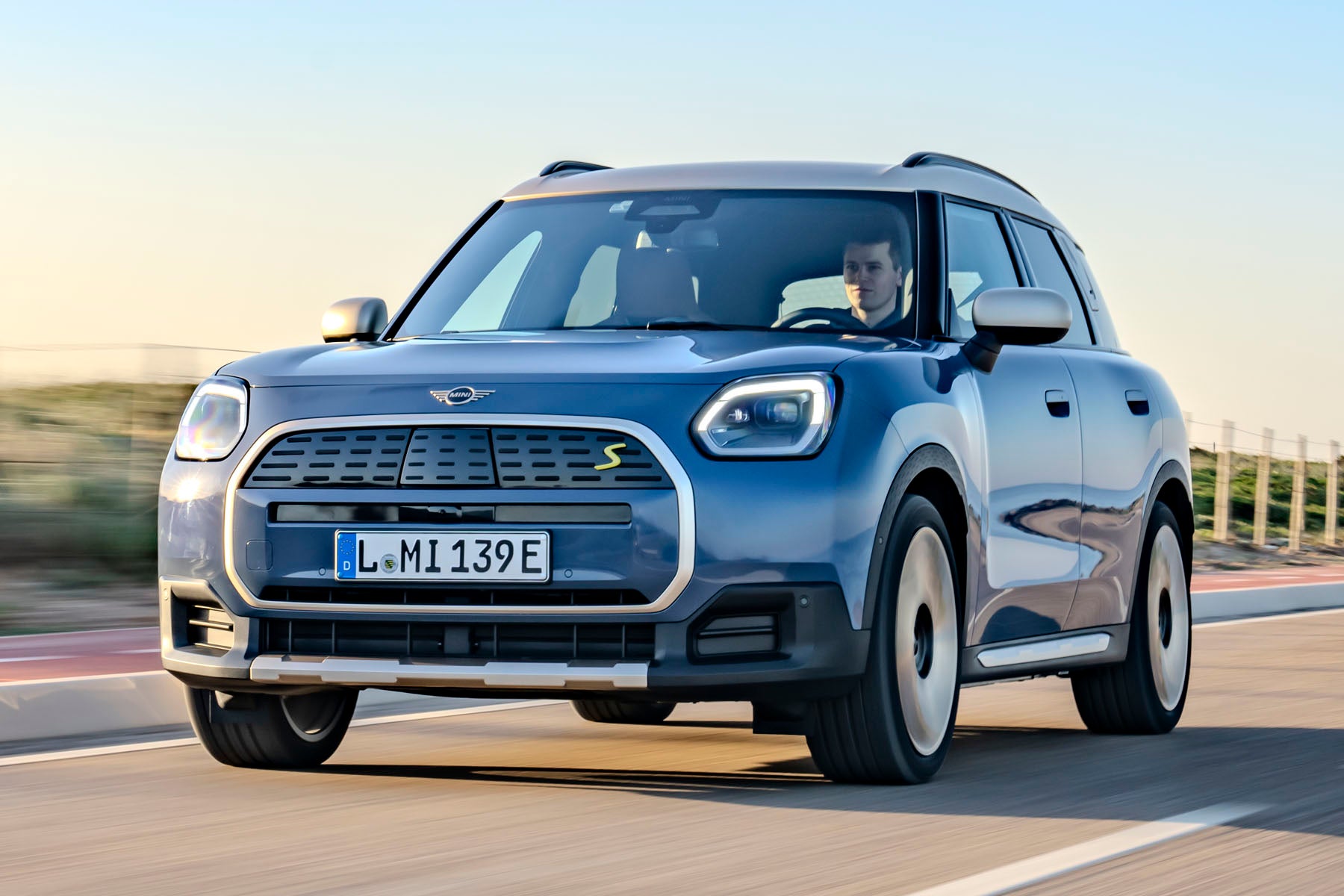MINI Countryman Electric Review 2025: Price, specs & boot space
Written by Antony Ingram
- 2024
- Small SUV
- EV
Quick overview
Pros
- Fabulous interior design
- Good to drive
- Endless personalisation options
Cons
- Touchscreen and control distractions
- Firm ride
- Some rivals go further and charge faster
Overall verdict on the MINI Countryman Electric
"The MINI Countryman is now in its third generation, and things have moved fast since the first model arrived in 2010. The latest Countryman is the biggest yet, but also the most visually striking and is finally available in all-electric Countryman E and Countryman SE forms, with front- and all-wheel drive and different levels of performance."
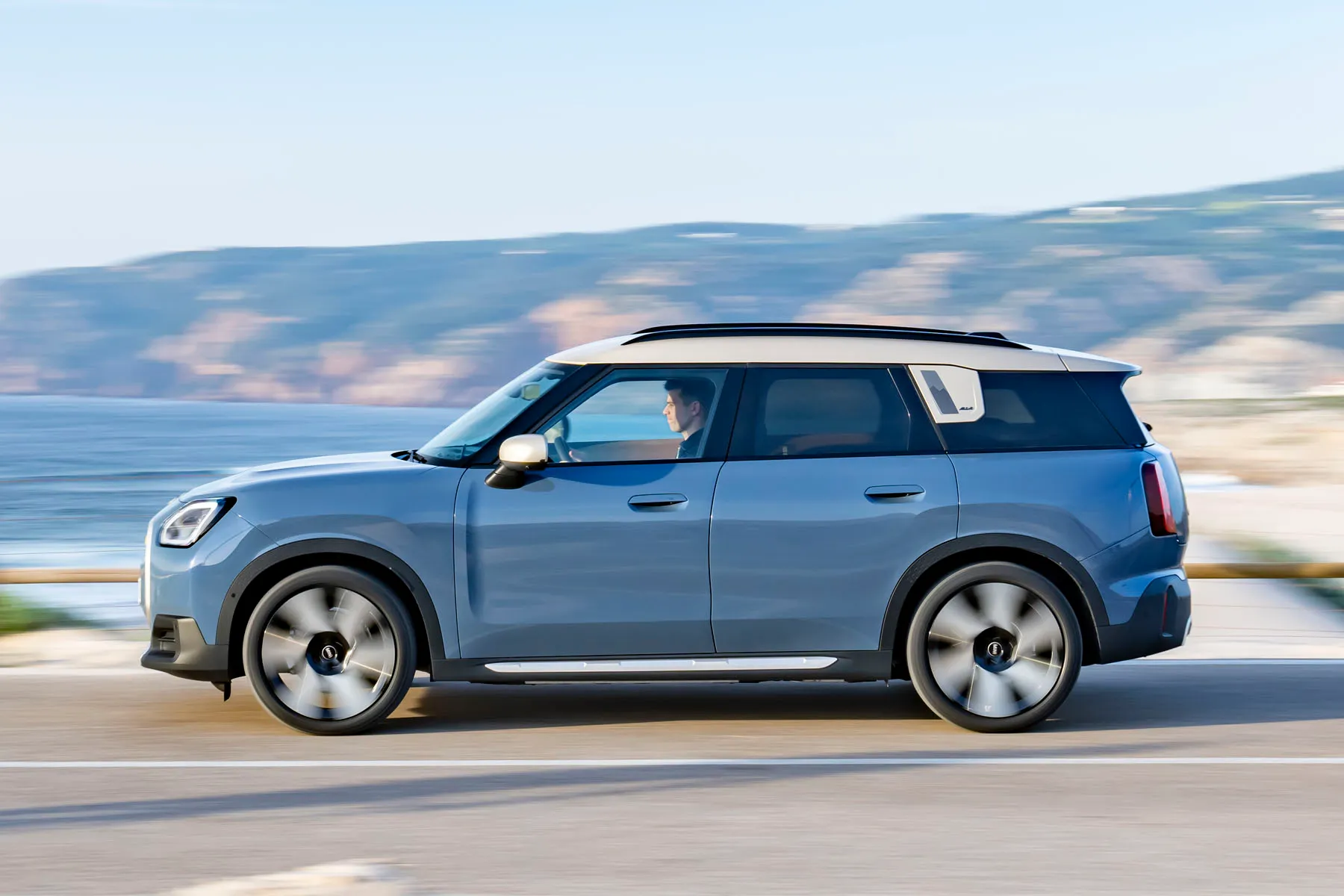
Style is a big part of why people buy MINIs and it’s going to be an even bigger factor with the latest car. The Countryman Electric's exterior design has that familiar MINI look but mixes in a kind of Land Rover Defender-style chunkiness and some seriously neat touches – dive into the settings and you can even change the lighting signature of the segmented tail lights between three different themes.
The interior though is where MINI has really shaken things up. The MINI Countryman Electric has one of the best-looking cabins of any modern car. From its industry-first circular OLED infotainment screen to the fabric-covered dash, vegan-friendly materials (and recycled materials both inside and out too – the Countryman’s alloy wheels use 70% recycled content) and vibrant colour schemes, it’s a real breath of fresh air in this segment.
It feels MINI-like to drive too, and while that means putting up with a fairly firm and bouncy ride, you get nimble handling and in SE form at least, brisk performance. You get a decent range too – up to 286 miles in front-wheel drive spec, but we’d anticipate easily over 200 miles real-world for most drivers.
There are cheaper EVs out there that’ll get you further (MINI Countryman S pricing starts just over £42,000) but very few that are as stylish inside or out, or that have such a strong feelgood factor from behind the wheel.
Looking for a used car for sale? We've got 100s of MINI Approved Used Cars for Sale for you to choose from, including a wide range of MINI Countrymans for sale.
Is the MINI Countryman Electric right for you?
If you want your electric family crossover to stand out from the crowd then the MINI Countryman Electric is probably the one to do it – at least until everyone else has one too, though MINI’s level of personalisation means your neighbour would have to try pretty hard to buy one that looked the same. The new Countryman Electric ticks all the desirability boxes but it’s practical enough too, and while it doesn’t offer the most range for the money, it’s certainly the most usable MINI-badged EV yet.
What’s the best MINI Countryman Electric model/engine to choose?
There are two powertrains in the Countryman Electric range: E and SE. So far we’ve only tried the latter, and the 313PS unit is shared with that in the BMW iX1 and iX2 xDrive30 models. The more potent version does require spending a little more up front as you’d expect – upwards of £47,180 rather than £42,080 – but on the plus side that’s barely more than a basic BMW iX1 in Sport trim for a car of similar size, greater performance, and a more inviting cabin. If you don’t need the SE’s extra performance and all-wheel drive, we suspect the lower-priced E will be even more appealing.
What other cars are similar to the MINI Countryman Electric?
In terms of mechanical similarity then the MINI Countryman Electric’s closest relation is the BMW iX1, which uses the same platform, motors and battery packs. Against the iX1’s pricing though the Countryman seems a bit of a bargain, starting at around £4000 less.
In contrast, it’s a little more expensive than the slightly larger Nissan Ariya, which also goes further on a charge, and only a little less than the starting price of the Ford Mustang Mach-E, which is bigger still, quicker than the Countryman E and offers similar range. It’s an increasingly busy segment though, and the MINI’s pricing puts it into contention with everything from the Hyundai Ioniq 5 to the Tesla Model Y.
Comfort and design: MINI Countryman Electric interior
"The MINI Countryman Electric’s cabin isn’t just a highlight of the car, but probably of the entire industry right now. Put simply it’s fantastic, brimming with the kind of colour and creativity that’s all too rare in most car interiors. And while you ideally need a high-spec model like the SE to really make the most of it, the minimalist look, fabric-trimmed dash and central OLED display are standard across the range."
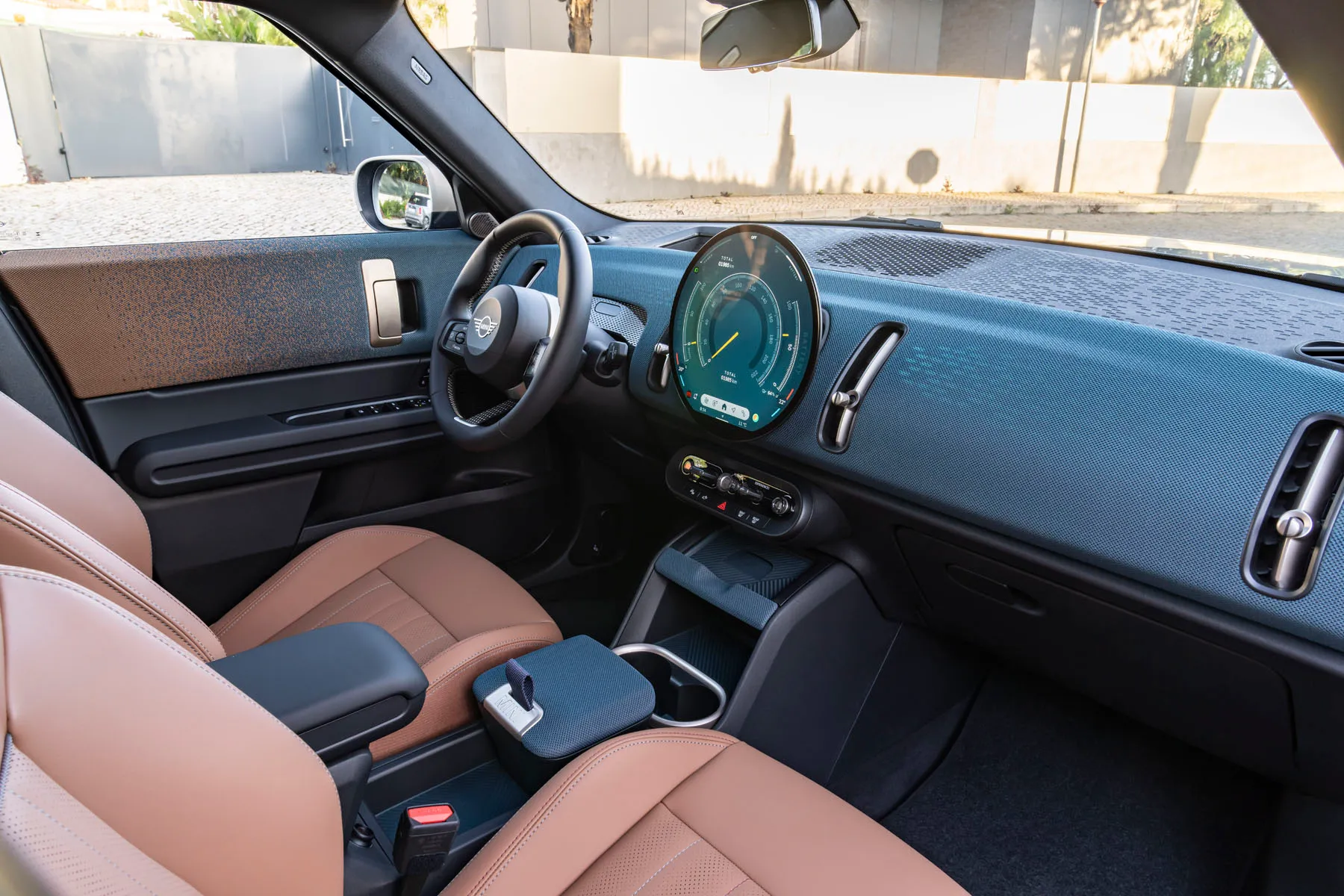
Our favourite bits, in no particular order, include the little fabric strap that turns a two-spoke steering wheel into a three-spoke one, the fabric-covered dash top which often hides a contrasting colour underneath and houses the vertical air vents (and in some models, the weave fades into a different colour towards the back of the car), the vertical metal door handles, the comfortable and beautifully designed seats, and the round OLED display (complemented by a head-up display on some models for the car’s vitals, just below your field of vision).
As minor criticisms we’d say that the fabric on the dash and door tops doesn’t feel very soft, but it’s probably hard-wearing as a result. And on the little bank of toggle switches below the round display, the power switch, drive selector switch and MINI Experience Modes switches are arguably a little too similar in appearance and a little too close together; it’s easy to imagine someone wanting to select a different drive mode and putting the car into neutral, for instance.
But otherwise the cabin also feels airy and spacious in both the front and rear, the latter helped by this Countryman being longer than its predecessor. Rear seat passengers still get those fabulous colours and trims and a couple of vertical air vents to play with, and passengers in both rows benefit from more cabin width too.
Quality and finish
As well as being a joy to look at, the Countryman’s interior is also a pleasure to interact with. We’ve mentioned the fabric surfaces feeling a little rough (think more hessian bag-for-life than knitted training shoe) but it still beats plastic, and gives the impression it’ll last for a good while. The synthetic leather feels great too, as soft as the real deal, and where there’s bog-standard plastic even that seems sturdy, just as the last few generations of Mini have been.
It’s nicely finished outside too, with tight shutlines and eyecatching design details that give the Countryman a chunky, quality, high-tech look from every angle. The ability to change the front and rear light signatures is great too, and adds a layer of personalisation we’ve not yet seen in other cars.
Infotainment: Touchscreen, USB, nav and stereo in the MINI Countryman Electric
Even more so than most modern cars, the Countryman’s infotainment display is probably one of its defining features. Taking centre stage on the dashboard is a completely round 240mm (about 9.4 inches, or only a little smaller than the wheels on a classic Mini) OLED display, which MINI proudly states is an automotive industry first. While it runs on MINI’s (well, BMW’s) ninth generation software, in the Countryman it’s all been configured in such a way that each layout suits the round display.
The shape doesn’t really change the function of course, though nor does it make certain functions, such as the heating and ventilation, any easier to use on the move than a rectangular screen would. Still, it’s quick to respond to most prompts and MINI has taken advantage of the shape to give most of the information displayed there enough space to breathe.
Perhaps the most interesting feature accessed through the screen (or via a small switch on a bank below, alongside the starter switch) is the MINI’s ‘Experience Modes’. There are too many to go into detail here, but essentially when you select the sporty Go-Kart mode, the retro-themed Timeless mode, the music-based Vivid mode, or the five others (Core, Green, Balance, Personal, and Trail), the theme of the screen, head-up display, and ambient lighting changes accordingly.
This means different colours and graphics (Go-Kart gets a sporty red and black theme, Timeless a parchment-style colour like the dials in a classic Mini), and several modes are accompanied by different driving sounds in the Countryman Electric too. Inevitably most people will settle on one they like (and actually changing between them is probably the slowest function on the touchscreen) but as a means of personalising the interior, it’s pretty flash.
Then there’s the MINI Intelligent Personal Assistant, which can be accessed by saying “Hey MINI”, bringing up either a stylised Countryman on the screen or Spike, a little cartoon dog, with voice control for various functions. Like Google and other personal assistants, it can also suggest certain routes or functions based on previous instructions.
Space and practicality: MINI Countryman Electric boot space
While the Countryman has grown there’s only been a modest increase in boot space, going from 450 litres with the seats up in the old car to 460 in the new one, and seats-folded capacity increasing from 1390 litres to 1450 litres. Still, an increase is an increase and the Countryman’s relatively upright shape gives a sensibly squared-off space for luggage. The rear seats don’t fold completely flat but do split three ways.
The Countryman Electric has an under-floor storage area for stashing the charging cables, and there are a few cubbies dotted around the cabin for the benefit of passengers too. The door bins are better for storing bottles than they are documents (both front and rear), and for front seat passengers, there are two smartphone-sized cubbies below the dash, a pair of cupholders, and then a neat centre cubby with a fabric pull strap to open it. There’s a tray behind that and another cubby under the armrest, so you’ll never be short of places to lose precious items.
Handling and ride quality: What is the MINI Countryman Electric like to drive?
"MINI will tell you its cars always have a ‘go-kart feel’ but with the larger models that’s only ever been true to a certain extent. With a kerb weight of over two tonnes the Countryman Electric isn’t about to change that, but it’s still one of the more amusing electric SUVs to drive, and to the company’s credit, it really does have a family feel you can trace down to MINI’s smaller models."
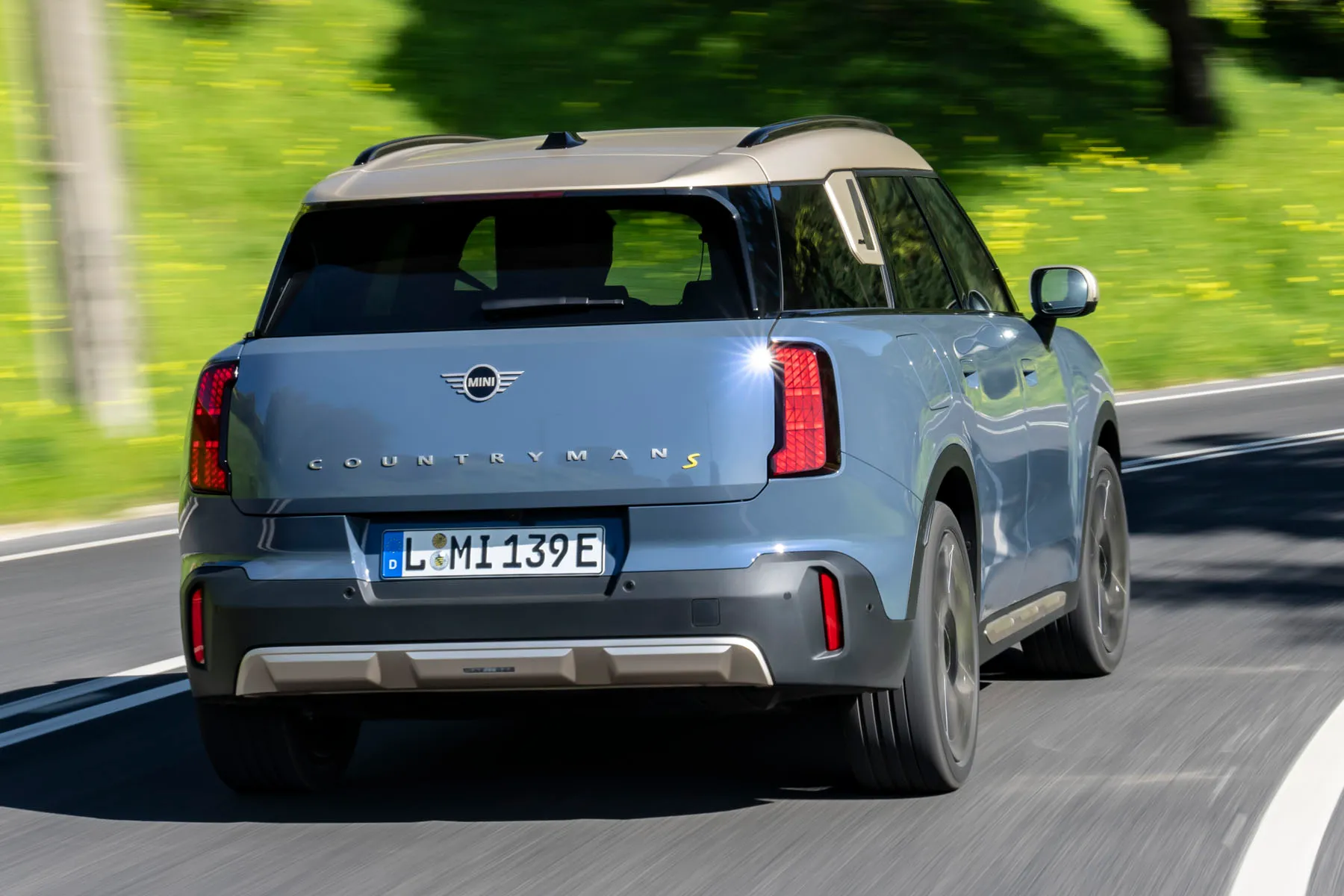
Two familiar characteristics from all MINIs are responsive steering and a fairly firm and occasionally bouncy ride quality. If you’re part of the MINI faithful you’ll probably put up with the slightly tough ride for the sporty feel it imbues, and the firm setup means body lean is kept to a minimum when you’re going in and out of corners, but there are definitely smoother-riding SUVs out there.
Still, it’s fun to chuck around and in Countryman SE form with the powerful twin-motor setup, you can slingshot out of corners with a quick flex of the ankle. The Countryman’s upright pillars and relatively high driving position mean great visibility too, which is just as important in town driving and on the motorway as it is on country roads. The ride settles down at speed and the weight gives the car a stable feel too.
What motors and batteries are available in the MINI Countryman Electric?
The new Countryman Electric is available in Countryman E and Countryman SE forms, with the former getting a 204PS motor at the front wheels and the latter an all-wheel drive setup, using a motor at each end for a combined 313PS. Both get the same battery pack with 64.6kWh of usable capacity, and both offer brisk performance: 0-62mph in 8.6 seconds in the E, and 5.6 seconds in the SE.
We’ve tried the Countryman SE so far, whose performance matches that of the BMW iX2 xDrive30, which sits on the same platform, and is just a little slower than the 5.4-second 0-62mph time of the petrol Countryman John Cooper Works. The SE feels good for its claimed mid-5s acceleration time, but understandably not quite as rapid as some other electric cars on the market – which is more a sign of just how quick some cars have become, rather than the Countryman feeling slow.
That said, you’ll want to select the Go-Kart ‘Experience Mode’ to feel the Countryman at its strongest. Acceleration is broadly similar in all modes but Green definitely mellows things out whereas Go-Kart feels as responsive as you’d expect of an EV, and as each Experience Mode gets its own sound, the accompanying noises are just a little more exciting in the sportiest mode. Flick the drive switch to B and you get enough regenerative braking for one-pedal driving, too.
Maximum electric range in the MINI Countryman Electric
Having just the one battery pack across the Countryman Electric range keeps things simple, but with different power outputs and drivetrain options, there’s still a difference in how far each model can go down the road.
Furthest is the front-wheel drive Countryman E, with a claimed 267-286 miles in Classic trim, while the Countryman SE, with its all-wheel drive and extra power, drops slightly to 251-266 miles. Those figures will of course be in relatively favourable conditions, and the roughly 3 miles/kWh we saw during our drive (which involved some brisk driving on twisty roads) suggests at least 200 miles is a realistic real-world estimate. In gentler driving, and with more opportunities to regenerate energy, we’d expect comfortably over 200 miles in mild weather.
Refinement and noise levels
No real surprises here, as the MINI Countryman Electric is hushed at almost any speed. The upright pillars seem to generate a rustle of wind at motorway speeds but not enough to be distracting, and the only other notable noises are the artificially generated ones the car plays when you accelerate. Given you can turn those off, they can’t really be criticised. Despite the firm ride, the Countryman does a good job of isolating you from road noises too, though we suspect some UK surfaces may still cause rumbles and resonances.
Safety equipment: How safe is the MINI Countryman Electric?
The MINI Countryman hasn’t yet been crash-tested in its current form but we’d be surprised if it’s anything less than a strong performer – partly as it’s similar under the skin to the current BMW X1, which received a five-star rating from Euro NCAP. Standard safety and convenience kit includes lane keep assist, forward collision warning, speed limit assist, a 360-degree parking camera and trailer assist, the latter to help when parking with a trailer. Optional features include steering assist and semi-automated driving at lower speeds.
Charging times: How much does it cost to charge the MINI Countryman Electric?
"The Countryman Electric offers a maximum DC charging rate of 130kW. Find a charger to supply that rate consistently and a 10-80% charge in either E or SE should take under half an hour, though this will vary in the real world. Charging at home at 11kW means a full charge in around 6.5 hours."
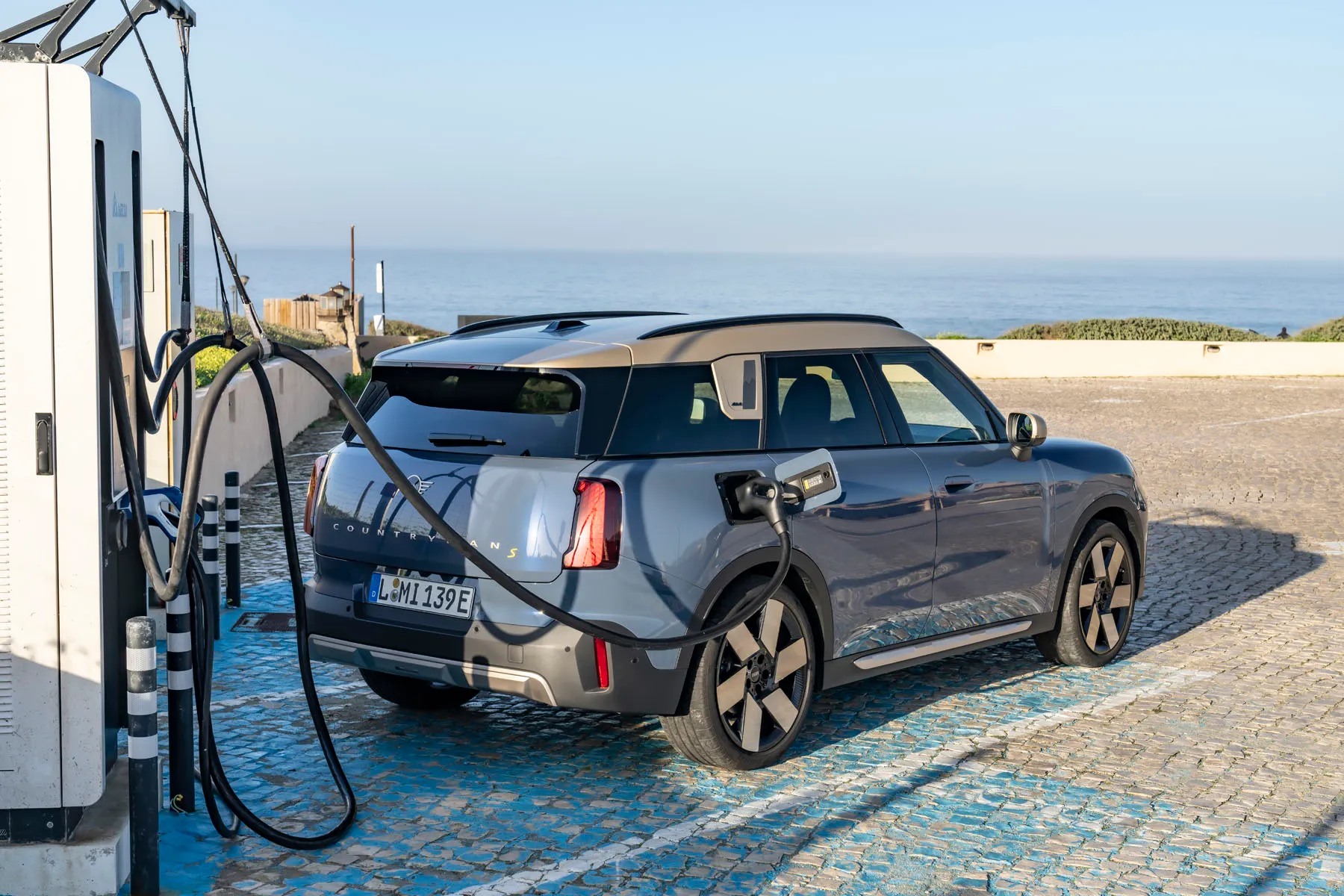
In terms of cost, that 70% top-up at a public fast charger, with average rates of around 74p/kWh, would set you back just over £33, while the 100% charge at home on an off-peak rate of 15p/kWh would be under £10, and if you get lower rates from your provider, you’ll be paying even less.
How reliable is a MINI Countryman Electric?
The MINI Countryman Electric is a little too new to have an idea about its long-term reliability, so we’re sure to hear over the next few years how it holds up. The existing Countryman hasn’t been too problematic though outside of a few isolated issues, though the brand as a whole has some way to go for overall customer satisfaction, finishing 25th from 29 brands in the 2023 Honest John Customer Satisfaction Index.
Insurance groups and costs
MINI hasn’t yet published insurance group ratings for the Countryman Electric. The outgoing Countryman was rated in groups 15-26, but electric cars tend to have higher ratings, and the closest parallel is probably the mechanically similar BMW iX1, which sits in groups 29-38.
VED car tax: What is the annual road tax on a MINI Countryman Electric?
If insurance might be a little expensive, then at least VED or ‘road tax’ won’t be. Like all EVs, the MINI Countryman Electric is currently free to tax, both in its first year when the car is registered, and thereafter. This is likely to change in future, though EVs will likely still be cheaper to tax than combustion-engined cars.
How much should you be paying for a used MINI Countryman Electric?
"A brand new MINI Countryman E starts at £42,080, and the SE at £47,180."
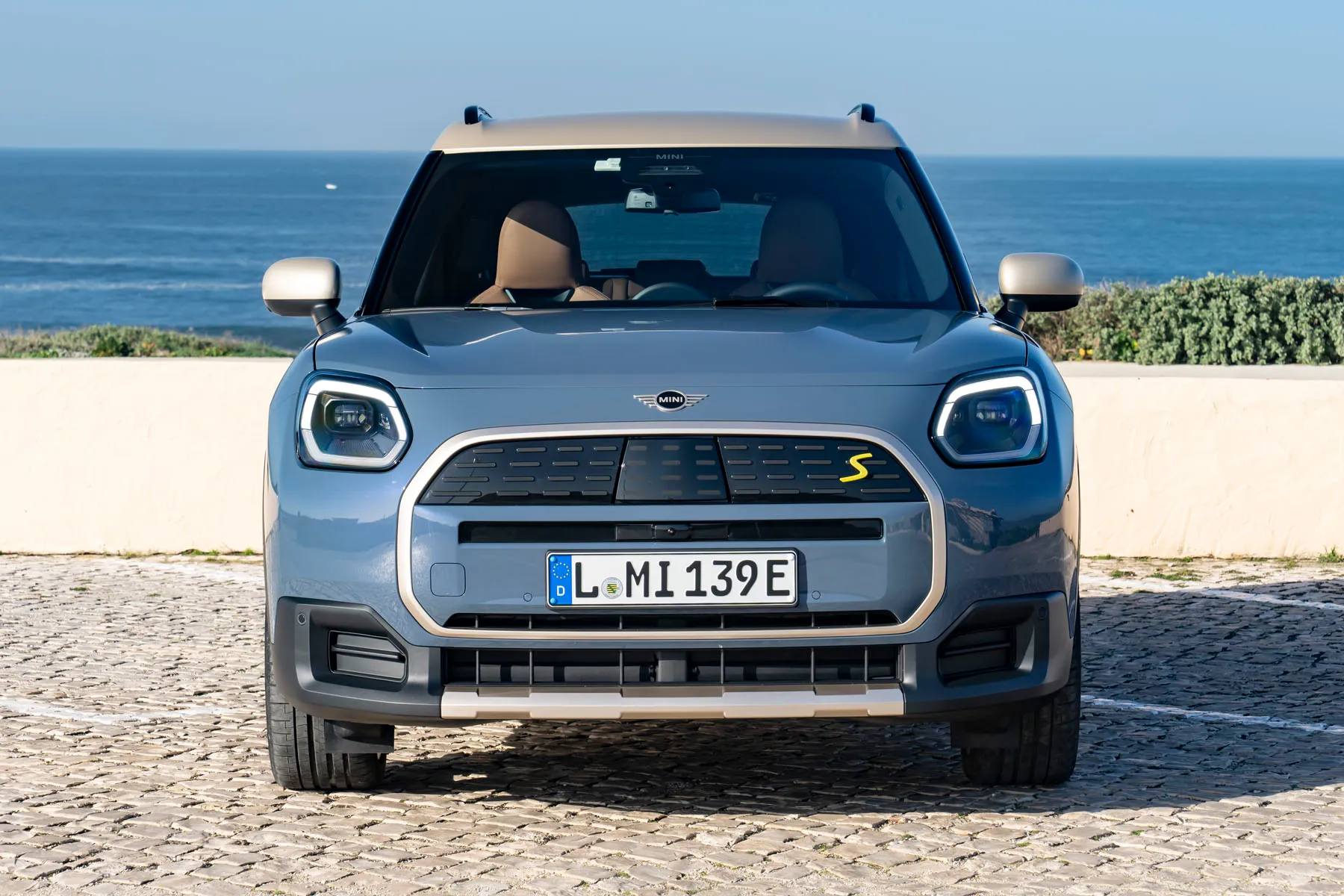
As this generation Countryman is brand new it’ll be a little while before used examples filter onto the market in any great number, but with depreciation on electric cars currently fairly severe, anyone wanting a bargain would be advised to hang on to see how the MINI fares.
Trim levels and standard equipment
In MINI Countryman E and SE Classic form you get LED front and rear lights, alloy wheels, that fancy circular OLED display with Apple CarPlay and Android Auto, ambient lighting, climate control, 11kW AC charging and 130kW DC charging (22kW AC is optional), cruise control, an automatic tailgate, and electrically adjustable and heated door mirrors. Classic trim also includes a black/blue textile dash design, Vescin artificial leather seats, a heated sports steering wheel, and a black grille surround.
Exclusive trim gets sports seats with perforated Vescin trim, a dark headliner, and silver exterior accents, while Sport features a look inspired by the petrol John Cooper Works variant, with 19-inch JCW alloy wheels, a black and red interior colour theme, and an optional red contrast roof.
Ask the heycar experts: common questions
Will MINI make a fully electric Countryman?
What is the range of the MINI Countryman Electric?
How much is the MINI Countryman Electric?
Get our latest advice, news and offers
Keep me updated by email with the latest advice, news and offers from heycar.
By submitting you agree to our privacy policy
